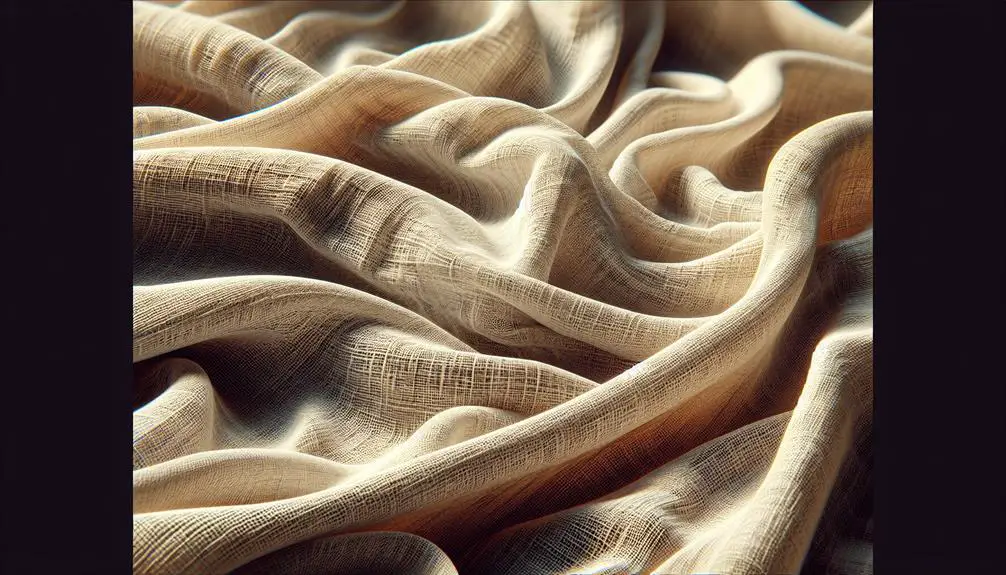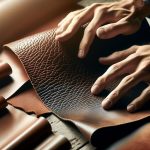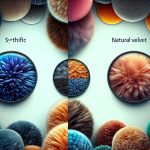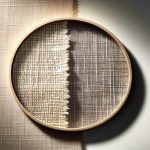When looking for 100% linen, feel for the fabric's texture and weight. Check for wrinkles, as linen wrinkles easily due to low elasticity. Test its absorbency – genuine linen can drink up lots of water. Look for slubs or irregularities in the weave, a telltale sign of authenticity. Earthy natural hues are typical of real linen. If you want to know more about identifying genuine linen, explore its evolution with each wash, durability compared to cotton, and other tests like the water spill test and texture inspection.
Table of Contents
Key Takeaways
- Look for earthy tones and muted colors typical of linen.
- Check for easy wrinkles that are characteristic of linen's lack of elasticity.
- Verify absorbency by observing how quickly it soaks up water.
- Inspect for slubs or irregularities in the fabric weave.
- Notice natural creases that reflect linen's low elasticity.
Fabric Color: Earthy Tones
When identifying 100% linen, one key indicator is the fabric color, which typically leans towards natural earthy tones like pale yellowish-gray. These muted hues are a hallmark of authentic linen, as this fabric is known for its connection to nature and sustainability.
Bright or vivid colors aren't common in linen textiles because the earthy tones mimic the hues of the flax plant from which linen originates. The subdued palette of linen adds to its charm and organic appeal, making it a popular choice for those who appreciate natural materials.
Wrinkle Test: Lack of Elasticity
When it comes to identifying 100% linen, understanding its lack of elasticity is essential.
Linen's natural tendency to wrinkle easily showcases its non-stretchy nature.
These wrinkles are a clear sign of authentic linen material.
Elasticity in Linen
Linen's lack of elasticity, evident in its propensity to wrinkle easily, contributes to its natural, relaxed appearance. Unlike fabrics made with cotton yarn, linen doesn't stretch much. This minimal stretch in linen is what gives it that unique, slightly rumpled look.
When wearing linen, expect those creases to form, but don't worry – they're part of the fabric's charm. The wrinkles are easy to smooth out by hand, and they add to the overall casual elegance of linen. Embrace the wrinkles as a sign of genuine linen; they showcase its natural texture and feel.
Wrinkle Resistance Test
One quick way to assess the authenticity of linen is by conducting a wrinkle resistance test to observe its lack of elasticity. Authentic linen's natural creases are a result of its low elasticity, making it prone to wrinkles.
When examining a fabric for linen content, the presence of wrinkles is a key indicator. Linen's characteristic of creasing easily and maintaining those wrinkles sets it apart from other materials.
Due to its lack of stretch, linen fabric tends to have a relaxed appearance with wrinkles throughout. By performing a simple wrinkle test and observing how the fabric holds creases, you can determine if the material is indeed 100% linen.
Fabric Texture Check
To determine if a fabric is 100% linen, one can examine its texture for a lack of elasticity through a simple wrinkle test. Linen's natural lack of elasticity means that when you crumple or fold it, the wrinkles will remain visible throughout the fabric. Unlike materials with stretch, linen maintains creases without bouncing back, showcasing its structured yet smooth texture.
Genuine linen consistently displays these wrinkles, giving it a relaxed appearance. By testing how well the fabric holds creases, you can gauge if it's truly 100% linen. Remember, the key is to look for those creases that persist throughout the fabric, indicating its lack of elasticity and confirming its authenticity.
Absorbency Check: Highly Absorbent
With its remarkable ability to absorb up to 20% of its weight in water, genuine linen stands out for its exceptional absorbency. When testing for linen authenticity, the fabric's absorbency is a key indicator. Authentic linen will swiftly soak up water without beading on the surface, showcasing its high absorbency rate. This distinguishing feature sets linen apart from other fabrics, making it a preferred choice for items like towels and clothing where absorbency is essential.
To determine if a fabric is 100% linen, conducting a simple absorbency test can be quite revealing. Pour a small amount of water onto the fabric and observe how quickly it's absorbed. Genuine linen will rapidly take in the water, demonstrating its characteristic absorbent nature. Additionally, once moistened, pure linen will dry relatively fast due to its absorbent properties. Mastering the art of recognizing linen's absorbency can help you confidently identify and appreciate this exquisite fabric.
Imperfections: Look for Slubs
When checking for linen authenticity, keep an eye out for slubs – those little irregularities in the fabric weave. These imperfections are a sign of genuine linen and contribute to its unique charm.
Feeling for slubs can be a quick way to confirm the real deal when identifying 100% linen products.
Checking for Slubs
When examining linen fabric for authenticity, feeling for the presence of slubs can be a telling sign of its high quality. Slubs are those tiny imperfections in the weave that are characteristic of real linen. Machine-made polyester linen lacks these slubs, making them a key feature of authentic linen textiles.
By running your hand over the fabric, you can easily detect these natural and organic irregularities. The presence of slubs not only enhances the authenticity of the linen but also adds to its overall appeal. If you're checking for slubs in a fabric, you're on the right track to determining if it's indeed 100% linen.
Natural Irregularities
Let's move from examining slubs to exploring the natural irregularities in linen fabric, particularly focusing on the presence of slubs as a key indicator of authenticity and quality. Genuine linen is characterized by these natural imperfections, known as slubs, which are tiny irregularities in the weave.
The presence of slubs in linen fabric is a clear sign of high quality and authenticity. Unlike machine-made polyester linen, real linen showcases these unique slubs. To identify authentic linen, run your hand over the fabric to feel for these slubs.
Embracing these slubs as part of linen's organic appeal is essential when differentiating between genuine linen and synthetic imitations. Remember, the presence of slubs is a significant feature to look for when verifying the authenticity of linen.
Authenticity Through Imperfections
To truly verify the authenticity of linen, one must carefully inspect the fabric for the presence of tiny imperfections known as 'slubs' in the weave. These slubs are natural irregularities in the fabric that indicate high-quality linen material. Machine-made polyester linen typically lacks these slubs, making it easier to distinguish from authentic linen. Running your hand over the fabric can help you detect the presence of these slubs. They are a key characteristic of authentic linen, showcasing its organic appeal. Below is a table summarizing the importance of slubs in identifying genuine linen fabric:
| Importance of Slubs in Identifying Linen Fabric |
|---|
| Natural irregularities |
| High-quality material |
| Absence in polyester linen |
| Detectable by touch |
| Organic appeal |
Natural Creases: Indicate Authenticity
Featuring natural creases that reflect its low elasticity, authentic linen fabric boasts a soft silhouette that sets it apart from imitations. These organic folds are a distinctive characteristic of real linen, showcasing its high quality and natural origin. When examining linen, pay attention to the way it holds creases and folds. Real linen tends to maintain these patterns, while fake linen often resists wrinkles and lacks the soft, flowing appearance of authentic linen.
The presence of natural creases is a key indicator of real linen made from flax fibers. Be wary of perfectly ironed fabrics that appear flawless, as they may lack the organic creases that are inherent to genuine linen. Embrace the imperfect beauty of natural creases, as they not only add to the authenticity of the fabric but also contribute to its unique charm and character. Remember, real linen is meant to be lived in and loved, creases and all.
Softness Over Time: Flax Linen Trait
As flax linen ages, it gradually enhances its softness with each wash, offering a luxurious and comfortable feel over time. Quality linen products stand out for their ability to improve in texture with use, providing a smooth and pleasant experience as they mature.
Here are some key points to contemplate about the softness of flax linen over time:
- Authentic flax linen becomes softer with each wash, improving in texture as it ages.
- Initially rough, linen softens over time with use, offering a comfortable and luxurious feel.
- The softness of real flax linen enhances gradually, providing a unique and graceful usage experience.
- With successive washes, linen's softness and comfort increase, making it a durable and favored choice for various products.
Understanding how flax linen evolves in softness over time can help you appreciate the luxurious feel and durability of this exceptional fabric.
Fabric Durability: Sturdy Material
Linen fabric's durability is a key characteristic due to its exceptional strength, surpassing that of cotton by 2-3 times. This sturdiness makes linen a reliable choice for various applications. Authentic linen products are known for their longevity, as they resist wear and tear, showcasing the fabric's durability.
Despite its low GSM, linen remains strong and can endure regular use without losing its integrity. Genuine linen items maintain their quality even after years of use, emphasizing the fabric's durability. This robust nature of linen makes it a popular choice for items that require resilience and longevity.
When seeking a material that can withstand the test of time, linen's fabric durability stands out as a sturdy and dependable option.
Water Spill Test: Absorbency Confirmation
When testing for 100% linen, one key point is its absorbency rate.
Genuine linen quickly absorbs water due to its high moisture-wicking abilities.
This quick absorption can be a reliable confirmation of authentic linen fabric.
Absorbency as Indicator
I find that a quick water spill test on a corner of the fabric is a reliable way to confirm the high absorbency of genuine 100% linen. When conducting this test, look for the water to be quickly and evenly absorbed without beading up on the surface, indicating authentic linen material. Additionally, genuine linen will dry relatively fast after the water spill test. Testing the water absorption rate of the fabric can be a key factor in distinguishing real 100% linen from blends or imitations.
- Look for quick and even water absorption.
- Avoid beading up on the fabric surface.
- Genuine linen dries relatively fast after the test.
- Water absorption rate helps identify authentic 100% linen.
Quick Water Absorption
To assess the authenticity of 100% linen, employ a quick water spill test to observe the fabric's absorbency characteristics. Authentic linen fabric is known for how fast it absorbs water due to its high moisture-wicking properties.
When conducting the water spill test, genuine linen will absorb up to 20% of its weight before showing any signs of dampness. Additionally, the water should spread evenly on the fabric without beading up.
Another indicator of authenticity is how quickly the water dries on the linen fabric. For consistent results, it's advisable to conduct the water absorption test in various areas of the fabric.
Texture Inspection: Touch and Feel
Feeling the texture of linen is key to distinguishing genuine flax linen from imitations. When examining the texture of linen, consider the following:
- Real flax linen has a distinct weight and texture that sets it apart from synthetic alternatives.
- Genuine linen feels thick and showcases a unique weave pattern when touched.
- Running your hand over linen can reveal tiny imperfections known as 'slubs' in the weave, indicating authenticity and high quality.
- The coolness of linen to the touch is another characteristic that can help in identifying authentic flax linen.
Color Examination: Natural Hues
When examining linen to determine its authenticity, observe the natural hues present in the fabric as they're indicative of its organic origin. Natural colors like pale yellowish-gray are often found in linen, and these hues are a key indicator of the fabric's purity.
Authentic linen products showcase these natural colors, reflecting their organic origin from flax plants. By paying attention to the distinct natural color tones in linen, you can gain insight into the material's genuineness.
These natural hues not only add to the aesthetic appeal of linen but also serve as a reliable marker of its quality. When identifying linen, remember to look for these characteristic natural colors as they play a significant role in verifying the authenticity of the fabric.
Overall Evaluation: Genuine Linen Traits
As we advance to evaluating authentic linen traits, it's important to acknowledge the distinct characteristics that differentiate true linen from other fabrics. When appraising if a fabric is genuine linen, consider the following traits:
- Strength: True linen is crafted from flax fibers, which are markedly 2-3 times stronger than cotton fibers.
- Absorbency: Look for the fabric's cool, absorbent, and moisture-wicking properties, indicative of genuine linen.
- Color: Authentic linen products often exhibit natural hues like pale yellowish-gray, reflecting the material's purity.
- Texture: Genuine linen lacks elasticity, resulting in natural wrinkles and creases throughout the fabric, showcasing its sturdiness and durability.
Frequently Asked Questions
What Does 100% Linen Feel Like?
When I touch 100% linen, it feels cool, slightly rough yet soft with each wash. The fabric is lightweight, durable, crisp, and smooth. Its unique texture and luxurious feel make it ideal for warm weather clothing and home textiles.
How Can You Tell High Quality Linen?
To identify high-quality linen, I look for slubs in the weave, quick water absorption, a thick feel with a unique weave, and when burned, it produces a steady flame, fine ash, and a scent like burning paper.
Is 100% Linen Scratchy?
At first, 100% linen might feel rough, but it softens with washing. Its natural fibers may appear scratchy initially, but over time, it becomes more comfortable. The fabric's breathability and moisture-wicking properties add to its comfort.
What Is the Difference Between 100% Linen and Cotton Linen?
I'll explain the differences between 100% linen and cotton linen. 100% linen originates from flax fibers, while cotton linen combines cotton with linen. The former boasts high absorbency and a distinctive texture, while the latter may offer a softer feel and fewer wrinkles.
- Tetron Fabric for Marine Applications: Durability and Use Cases - June 18, 2025
- Tetron Fabric for Outdoor Furniture: Weather Resistance and Care - June 18, 2025
- Tetron Fabric for Wall Coverings: Style and Application Tips - June 18, 2025







